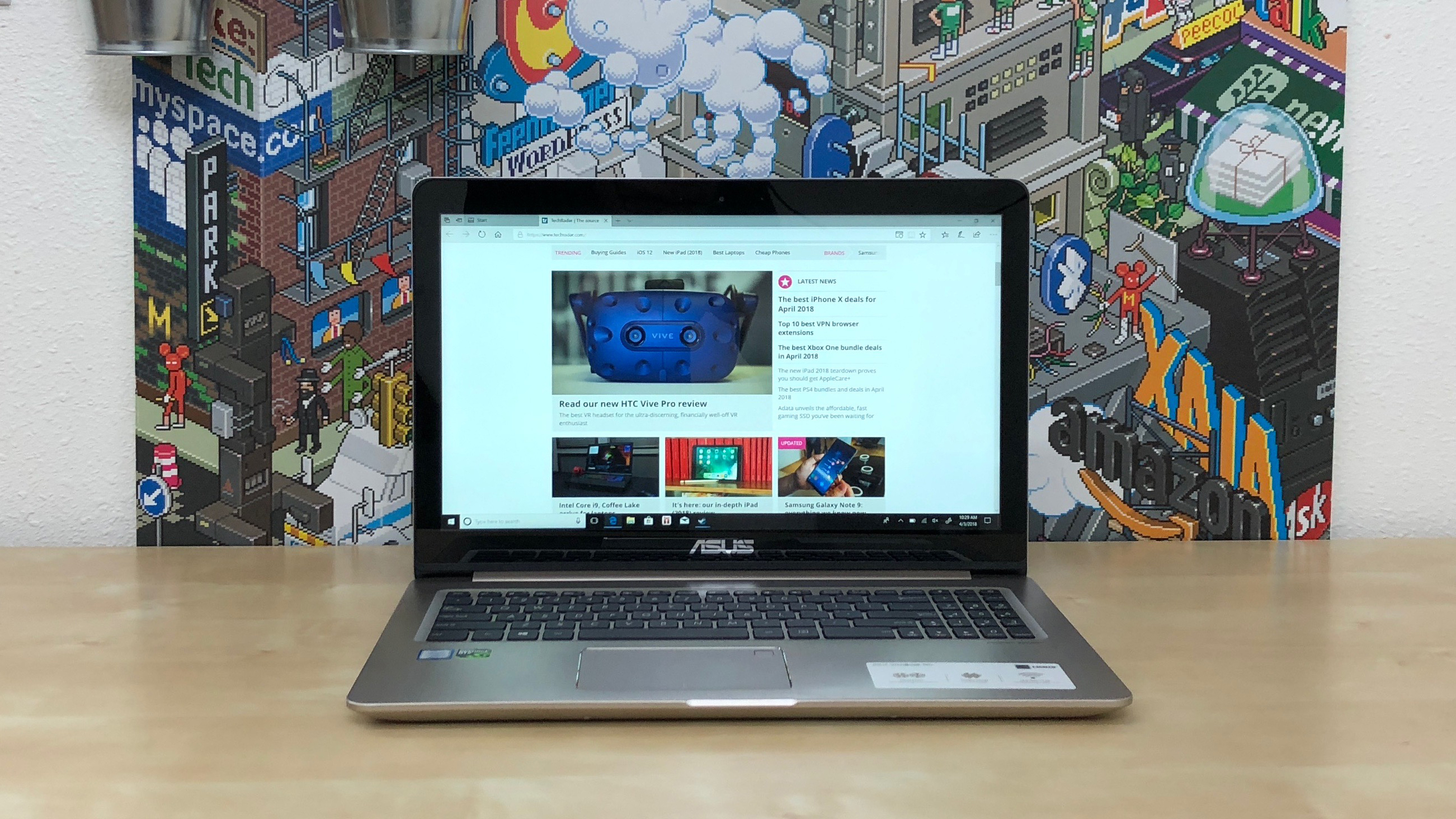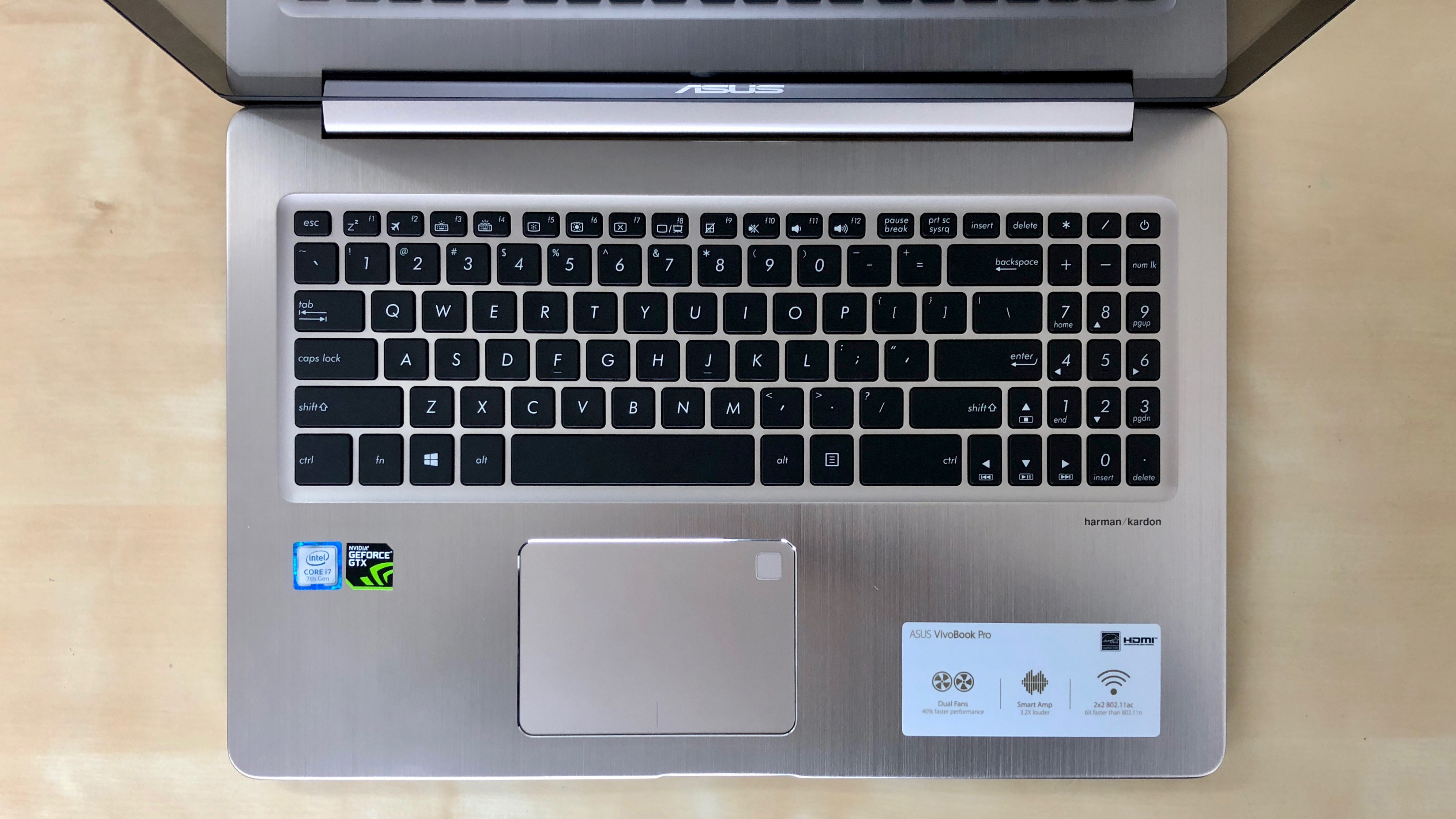TechRadar Verdict
The VivoBook Pro 15 is an affordable laptop that’s long-lasting and packs a punch, but this notebook has one quirk (or two) that may drive you crazy.
Pros
- +
Ports for days
- +
Nice mix of work and play
- +
Respectable battery life
Cons
- -
Awkward fingerprint sensor placement
- -
Finicky touchpad
Why you can trust TechRadar
The Asus VivoBook line of laptops spans the entire spectrum of users. From the slim and affordable VivoBook S to the VivoBook Flip that’s even smaller and built for all sorts of contortions and use cases, to the VivoBook Pro, designed to combine portability with power.
Despite the ‘Pro’ name tag, Asus has managed to build a robust laptop (albeit on the heavy side of portability) and price it somewhere more in line with what most users pay for a 2-in-1 laptop. Oh, and did we mention it has GTX 1050 graphics inside? Just in case, you know, you want to distract yourself from work with a few matches of PlayerUnknown’s Battlegrounds (PUBG).
Here is the Asus VivoBook 15 configuration sent to TechRadar for review:
CPU: 2.8GHz Intel Core i7-7700HQ (6M Cache, up to 3.8GHz)
Graphics: Nvidia GeForce GTX 1050 (4GB GDDR5 VRAM), Intel HD Graphics 630
RAM: 16GB DDR4 SDRAM (2,400Mhz)
Screen: 15.6-inch, FHD (1,920 x 1,080) with 178˚ wide-viewing angle
Storage: 512GB SSD (M.2 SATA3)
Ports: 1 x USB 3.1 Type-A, 1 x USB 3.1 Type-C, 2 x USB 2.0, 1 x RJ45, 1 x HDMI, 1 x SDXC reader, 1 x headphone/mic jack
Connectivity: 802.11ac Wi-Fi, Bluetooth 4.2
Camera: HD webcam (720p)
Weight: 5.05 pounds (2.29 kg)
Size: 15 x 10 x 0.8 inches (380 x 256 x 19.2 mm; W x D x H)
Price and availability
The VivoBook Pro 15 is currently priced at $1,169 on Amazon, mirroring the specifications of the device we received for review. In the UK and Australia, however, things are a bit more complicated. The N580VD model is listed on the Asus website for both countries, but the Australian Asus website only reveals the product isn’t currently available. As for the UK listing on the Asus site, well, it’s missing a purchase button altogether.
As for the US version, the Asus website only lists the specific model we tested, while Amazon adds a 4K upgrade with a smaller SSD and a bonus 1TB for HDD for a couple of hundred dollars more.
At this price, the VivoBook Pro 15 is comfortably below the Dell XPS 15 and Apple’s MacBook Pro with Touch Bar. Surprisingly, a comparable 13-inch MacBook Pro isn’t on the high end of the pricing spectrum at $1,799 (£1,749, AU$2,699), but it lacks a dedicated graphics card. Whereas a similarly-specced 15-inch model goes for $2,699 (about £1,920, AU$3,511). As far as the XP 15 is concerned, you’re looking at $2,174 (£1,814, AU$2,634) for comparable specs to the VivoBook Pro 15.






Design
The light gold finish of the VivoBook Pro 15 easily recognizable and hard to miss. With a 15.6-inch display, the overall footprint of the VivoBook Pro 15 is a bit on the large side. Measuring 15 x 10 x 0.8 inches (380 x 256 x 19.2mm; W x D x H) and with a combination of metal and plastic housing, this laptop dances the line of tradeoffs for portability over durability, weighing 5.05 pounds (2.29kg).
The VivoBook 15 Pro is on the cusp of being too large for easy portability. You’ll undoubtedly notice a difference between the MacBook Pro (3.02 pounds) and VivoBook Pro 15 in your backpack when walking across campus.
Sign up to the TechRadar Pro newsletter to get all the top news, opinion, features and guidance your business needs to succeed!
As a laptop that’s labeled for pro users, the VivoBook Pro doesn’t disappoint when it comes to ports. On the left edge is where you’ll find the charging port, an RJ45 Ethernet port, USB 3.1, HDMI and a USB-C 3.1 port. The opposite edge is home to two USB 2.0 ports, an SD Card reader, 3.5mm headphone/microphone jack and two indicator lights.
With more than enough ports to connect external displays, either through HDMI or the USB-C port, along with Ethernet and USB ports for accessories and backup drives, you should be covered no matter your setup.
A nearly full-sized keyboard with chiclet keys is found just below the FHD display. The keys have a slim profile and are responsive. A relatively small number pad is present, but we found the keys a bit too thin to lend themselves to fast key-punching.

Let’s talk touch
Embedded near the top-right corner of the touchpad is a fingerprint sensor used to unlock the laptop. We’ve complained about touchpad with a fingerprint sensor inside the touchpad before, and we’d be remiss if it weren’t mentioned again.
Breaking up the flow of the touchpad is frustrating and not a decent trade-off for the added biometric feature. The sensor gets in the way, for example, when dragging text or a file across the display — there has to be a better way.
While we are talking about the touchpad, let’s address another issue we have with it: there’s not a clear-cut area that’s dedicated to right-clicks. Repeatedly we find ourselves using the touchpad and clicking our way around a website or app, only to randomly — and unintentionally — right-click on something.
To be fair, Asus has a small line on the bottom of the touchpad that splits the left and right side of the touchpad. But that isn’t a definitive guide, with a touch or click in the top-right quarter of the touchpad registering as a left-click most of the time. It’s the other random instances of errant right-clicks that lead to frustration.
Looking to save money on an Asus device? Check out our Asus coupon codes for big savings on top tech.
